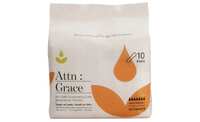posted by
Noel85
almost 3 years ago
Free pH Testing Strips for women
Get Sample
Offer Information:
Scarlet Society is offering a Free pH Testing Strips for women! Just fill out a form with your mailing address to receive your free testing strips. This offer is available while supplies last so sign up now and receive this free product!
Product Description:
Whether you test your vaginal pH level regularly due to recurrent infections or you have no idea your vagina has a normal vaginal pH range (and that you can easily get yours from the comfort of your own home!), read on. Here’s everything you need to know about what your vaginal pH level should be, why staying in the healthy range is important, and how to test yourself using a DIY vaginal pH swab.
First, What is pH?
The pH scale is a way to measure how acidic something is, with 0 being the most acidic, 7 being neutral, and 14 being alkaline. Different parts of your body have a different pH balance. For example, your stomach is acidic (usually 1.5 to 3.5), which helps it kill harmful bacteria and break down food. Your blood should be right in the middle of the scale, typically between 7.35 to 7.45.
The pH scale is a way to measure how acidic something is, with 0 being the most acidic, 7 being neutral, and 14 being alkaline. Different parts of your body have a different pH balance. For example, your stomach is acidic (usually 1.5 to 3.5), which helps it kill harmful bacteria and break down food. Your blood should be right in the middle of the scale, typically between 7.35 to 7.45.
Women in their childbearing years tend to have a normal vaginal pH level that leans towards the acidic side, around 3.8 to 4.5. Before menstruation and after menopause, a healthy, normal vaginal pH tends to be higher than 4.5.
An acidic vaginal pH is protective, as acid kills harmful bacteria, parasites, and fungi and helps protect your vagina against germs. In fact, having a vaginal pH level above 4.5 increases your risk for sexually transmitted diseases (STDs) such as trichomoniasis (a.k.a. trich) as well as bacterial vaginosis (BV), a condition that results from an overgrowth of bacteria.
So, What Causes an Unbalanced Vaginal pH?
Your vaginal pH can change based on a number of factors, including:
Your vaginal pH can change based on a number of factors, including:
Your menstrual cycle:
Vaginal pH increases when menstrual blood is in the vagina, according to research, becoming less acidic. In fact, the most common cause of a falsely elevated pH is any blood in the vagina, says Lauren Streicher, MD, a clinical professor of obstetrics and gynecology at Northwestern University’s medical school. This can happen during your cycle, or even due to post-sex microscopic bleeding.
On the flip side, pregnancy may make your vaginal pH more acidic—which is nothing to worry about, unless you’re experiencing itching or burning. (Interestingly, oral contraceptives may also make your vaginal pH less acidic, making you more prone to bacterial overgrowth or yeast.)
Whether you’ve reached menopause:
Normal vaginal pH becomes higher (around 5.3, on average) in postmenopausal women, which scientists believe is caused by estrogen depletion. (In fact, research shows the use of estrogen therapy in postmenopausal women leads to a reduction in vaginal pH.)
What medication you’re taking:
Antibiotics tend to raise your vaginal pH because they kill all bacteria—the good and the bad. This in turn can upset the balance of bacteria in the vagina that creates a normal pH level.
Products you’re using to clean your vagina:
Douching (inserting a fluid mixture into your vagina with a tube or other tool to “clean” the inside of the vagina) disrupts the balance of bacteria in your vagina, which can raise your vaginal pH as a result. This is why experts recommend washing only the outside of your vaginal area, and with soap and water only.
Lubricants you’re using:
While your go-to lube may reduce dryness in the vaginal area to make sex more comfortable, many products have a pH that’s higher than 4.5, which can kill healthy bacteria and raise your vaginal pH as a result.
Unprotected sex:
Semen is alkaline, which can raise your vagina’s pH level and encourage the growth of certain bacteria. Plus, the penis has its own bacteria—and when these bacteria come in contact with your vaginal environment, it can upset your bacterial balance (and your vaginal pH as a result).
Signs Your Vaginal pH May Be Unbalanced
While there may be a number of no-big-deal reasons why your vaginal pH isn’t at the ideal 3.8 to 4.5, it can also be a sign that you’re dealing with a bacterial infection, STD, or other health issue. That’s why it’s important to understand some of the symptoms of an unbalanced vaginal pH, so you can test yourself with a DIY vaginal pH swab or schedule an appointment with your gynecologist.
Some of the most common symptoms your vaginal pH is off include:
- A strong, fish-like smell coming from your vaginal area
- Unusual vaginal discharge (grey, green, or foamy)
- Itchiness, irritation, or swelling around the vagina
- A burning sensation or pain while urinating or during sex
An unbalanced vaginal pH can ultimately lead to more serious illness and raises your risk for pelvic inflammatory disease, infertility, and STDs. So, if you’re experiencing any of these vaginal symptoms, you may want to test your vaginal pH to help you decide whether or not you need medical treatment.
How to Perform a Vaginal pH Test at Home
There are many test kits on the market, so it’s important to read the instructions that come with your test and follow the how-tos. In general, you’ll want to follow this expert advice that tends to apply to all at-home vaginal pH tests:
Step No. 1:
Wash your hands. You don’t want any bacteria, soap or hand lotion residue, or anything that might be hanging out on your hands mixing with the test strip.
Step No. 2:
Remove the pH swab from its packaging by the swab’s handle. It’s important that the pH paper doesn’t come in contact with anything—including your skin, your bathroom countertop, anything!
Step No. 3:
Hold the pH swab handle between your pointer finger and your thumb, and make sure the test strip is facing your thumb. Then, spread your labia with your other hand, insert the test strip into your vagina, and hold it there for 5 seconds. (Be sure to tilt the swab so the pH paper comes in contact with your vaginal wall.)
Step No. 4:
Remove the swab, being careful not to touch the paper, and compare the color of the strip with the color chart that came with your test. Some tests will provide a pH value based on this chart; others will only read “normal” or “abnormal.”
Interestingly, at-home vaginal pH tests are practically identical to the ones your doctor would use at an in-office visit, according to the U.S. Food and Drug Administration. However, your doctor will be able to provide a more thorough assessment and analysis of your overall vaginal health based on your health history, a physical exam, and other lab tests.
Interpreting Your Vaginal pH Test Results
It’s important to keep in mind that a vaginal pH test only measures vaginal acidity. That means it does not definitively diagnose any medical condition, STD, or other infection.
So, if your test results show your vaginal pH is more alkaline than it should be, take a deep breath, try not to freak out, and make an appointment with your gynecologist who can do further testing to help you figure out what exactly is going on. What’s more, if your vaginal pH test shows you’re in the normal range—but you have unusual symptoms—it’s still important to see your doctor.
In general, an elevated vaginal pH (anything over 4.5) may suggest bacterial vaginosis (BV), particularly when it’s accompanied with common symptoms of BV (like itchiness, vaginal discharge, and an unpleasant odor).
How to Maintain a Healthy, Normal Vaginal pH
While some things that mess with an optimal vaginal pH are out of your control, there are a few steps you can take to give yourself the best shot at maintaining balance:
-
Use condoms during sex. It’ll keep bacteria on the surface of the penis and prevent alkaline semen from entering your vagina, which can keep your vaginal pH balanced.
-
Avoid douching. Your vagina is self-cleaning! You do not need to use any kind of special product to clean inside or even around your vagina. Experts agree that simply rinsing the area around your vagina with water (and using a gentle soap if you must) is not only all you need to do, but it’s all you should do if you want to maintain a healthy, normal vaginal pH.
-
Consider your diet. Probiotic-rich food—think sauerkraut, yogurt, and fermented foods—may contain some of the same bacteria that live in your vagina, which can help the “good” bacteria thrive. Avoiding sugar-filled, highly-processed foods is also a smart move. They’re filled with ingredients that your vagina’s “bad” bacteria thrive on.
Community Reviews
-
Overall
-
Privacy
-
Getability
Community Insights
-
Always Free No Rebate Required
-
Everyone Gets One
-
Not Buy One to Get One Free
-
Available to Everyone
-
Does Not Require Membership
-
Not In Store Pick Up
-
Available in All Locations
-
Direct Offer, Not Via Service









Reviews
lifeslostpoetgrl
almost 3 years ago
Thanks.
Your Review or Comment
Sign in to comment